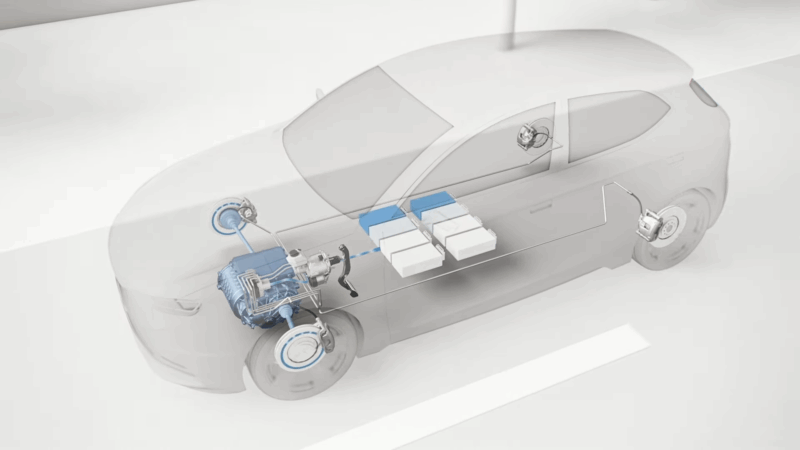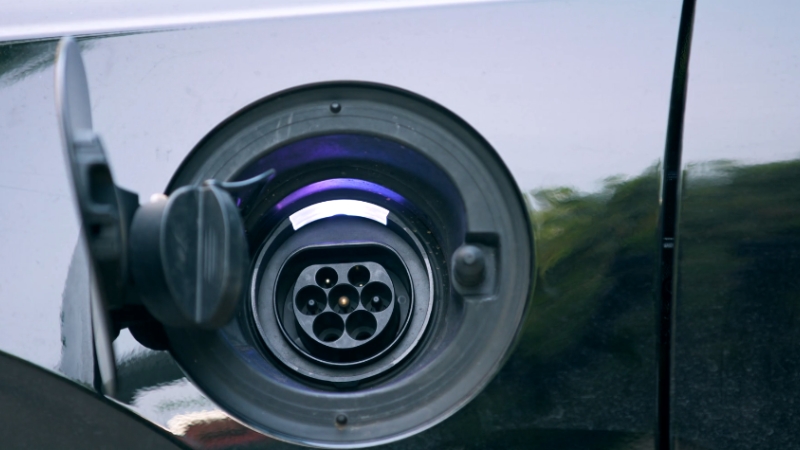Every time you slow your car down, energy is involved. In a regular gas-powered car, when you hit the brakes, that energy just turns into heat and disappears into the air, wasted.
Electric vehicles, on the other hand, decided to be smarter about it.
Regenerative braking (often just called “regen”) flips the script.
Instead of relying purely on friction brakes to slow the car, it uses the electric motor in reverse to generate electricity as the vehicle decelerates. That electricity gets sent back into the battery.
In simple terms? You’re turning your car’s momentum into a bit of extra battery charge.
How Regenerative Braking Works (Without Getting All Technical)
Here’s the basic flow:
And that’s happening in real-time, quietly, every day you drive your EV or hybrid. Some cars even let you adjust how aggressive the regen is—so you can coast more naturally or go full “one-pedal driving” where lifting your foot slows the car enough to stop it.
Wait, So How Much Energy Does It Recover?
This is where it gets a bit sobering. The amount of energy recovered depends heavily on your driving conditions.
Here’s a rough idea of what you might recoup:
Driving Scenario
Regen Recovery Estimate
City driving with stop-and-go traffic
20–30% of used energy is used
Downhill driving
10–15% of used energy is used
Highway cruising
5% or less
That might not sound huge, but over time it adds up. On a 250-mile range EV, good regen use can easily add 30–50 miles to your effective range over a week in city driving. Not too shabby.
Can It Make Your Battery Last Longer?

Let’s be clear: regenerative braking doesn’t directly improve the long-term health of your battery magically.
The chemistry of lithium-ion cells still degrades over time, based on charge cycles, heat, and how deeply the battery is discharged.
But regen can reduce wear and tear in a few indirect ways:
1. Fewer Full Charge Cycles
Every time you use regen to top up the battery while driving, you’re effectively using fewer full “wall plug” charging sessions. Less stress on the battery = slower degradation.
2. Lower Peak Heat Loads
Braking generates heat. A lot of it. Traditional friction brakes heat brake pads and rotors like crazy, and that heat can radiate to surrounding components.
Using regen more often keeps that thermal stress lower, especially on extended downhill runs.
3. More Predictable Discharge Patterns
EV battery management systems love predictability. Frequent regen means more moderate usage patterns, lots of little charges and discharges instead of extremely high-drain and full-recharge behavior.
Does that guarantee your battery will last longer? Not exactly. But it’s like eating your veggies, maybe not glamorous, but beneficial over time.
What About Maintenance Savings?
When we talk about electric vehicles (EVs), one of the standout features that often goes underappreciated is regenerative braking. This ingenious technology not only enhances the driving experience but also significantly boosts the efficiency of electric cars. If you’re curious… pic.twitter.com/i9I2iAUDMf
— Piotr Pawlak (@pawlakp) November 11, 2024
Now we’re talking dollars.
One of the often-overlooked upsides of regenerative braking is how much less work your mechanical brakes have to do. That can mean:
Drivers in urban areas especially notice this. Tesla Model 3 and Nissan Leaf owners have reported going over 100,000 miles before needing their first brake job—something unheard of in the gas-car world.
So even if regen doesn’t directly preserve your battery, it can preserve your wallet.
Real-World Tips: How to Make the Most of Regen
If you’re driving an EV and want to take full advantage of regenerative braking, not just for range but also for smoother driving, better brake longevity, and maybe even stretching out your battery’s useful life, there are a few things you can do differently.
Nothing dramatic. Just small shifts in how you approach slowing down and managing momentum.
Here’s how to make regen work smarter for you.
Use One-Pedal Driving When It Fits Your Route
View this post on Instagram
Many EVs today offer a mode where lifting your foot off the accelerator slows the car down significantly, sometimes to a complete stop. This is called one-pedal driving, and it leans hard on regenerative braking instead of your physical brake pads.
If your EV gives you the option, try turning it on, especially in city driving or stop-and-go traffic. The experience can feel weird for the first hour or so, but once it clicks, it’s oddly satisfying.
Like you’re more connected to the flow of the car. It’s smoother, easier, and once you get the hang of it, you’ll wonder why we ever needed two pedals for slowing down.
Some EVs (like the Hyundai Ioniq 5 or Kia EV6) even let you adjust the strength of regen with paddle shifters. That’s a killer feature for tailoring it to how you drive—dial it up for dense city traffic, or back it off for freeway cruising.
Ease Off Early, Avoid Hard, Last-Minute Braking
This one’s simple, but it makes a big difference.
When you stomp on the brake pedal, especially suddenly, your car often skips regen entirely and defaults to mechanical braking. That means friction takes over, and energy that could’ve gone back into the battery just vanishes as heat.
Instead, try lifting off the accelerator a little earlier when approaching lights, stop signs, or traffic. Give the regen system time to work. Smooth deceleration not only reclaims more energy, it also feels better to your passengers (and your future self when you realize you haven’t had to replace brake pads in 80,000 miles).
Pro tip: once you know your car’s regen “feel,” you’ll start reading traffic patterns differently—coasting into red lights, keeping better distance on downhills, and letting regen do more of the work.
Learn When to Coast Instead of Regen
Here’s where it gets a little nerdy, but also more efficient.
Regenerative braking is great for recapturing energy, but sometimes, not slowing down is more efficient than slowing down and re-accelerating again.
That’s where coasting comes in. Some EVs have a coast mode or low-regen setting that mimics the glide you get in a gas car when you take your foot off the pedal. It’s especially useful:
In Teslas, for example, regen is always on, but you can control how much by how quickly you lift off the pedal. In Hyundai and Kia EVs, you can go full manual with regen paddle levels.
Learn how your car behaves, and you’ll start to instinctively pick the most efficient strategy for each situation.
Mind Your Battery Temperature

Your battery doesn’t like it too hot or too cold. And regen systems are pretty picky about temperature, too.
When your battery is cold (like in winter mornings), regen might be reduced or completely unavailable until the pack warms up. The car will still drive just fine, but you might notice the brakes feel a bit different, and you’ll be using more of the mechanical system to slow down.
Same deal on the other end: if the battery’s already toasty from a long drive or heat wave, regen might be dialed back to prevent overheating.
Here’s how to keep things balanced:
- Park in a garage or shade when possible to protect battery temps.
- Precondition the battery if your EV supports it—most do, and it’s especially handy in cold weather.
- Avoid repeated hard braking when it’s blazing hot out. The thermal system will do its best, but give it a break when you can.
Many EVs show you a regen “limit” indicator on the dash, usually a dashed or greyed-out section of the power meter. Keep an eye on that if you’re not sure what’s happening.
Are There Any Downsides?
A few. Nothing too crazy, but good to know:
- Slippery Conditions: In icy or rainy weather, aggressive regen can sometimes unsettle the car. Most modern EVs compensate with traction control, but it’s something to watch for.
- Limited at Full Charge: If your battery is topped up, there’s no room for regen energy, so your brakes may feel different or weaker until the charge drops.
- Driving Feel: Some folks find strong regen unnatural, especially when switching from gas cars. But most people adapt in a few days.
Cars That Do Regen Well
@ev_tech How does #regenerativebraking for #electriccars work? #evtech #evtechnology ♬ original sound – EV Technology Learning
Some EVs and plug-in hybrids just nail it when it comes to smooth, efficient regenerative braking.
Here are a few standouts:
Vehicle
Regen Highlights
Tesla Model 3/Y
Seamless one-pedal driving, aggressive regen
Nissan Leaf
“e-Pedal” mode is intuitive and effective
Hyundai Ioniq 5
Adjustable regen paddles on the steering wheel
Chevy Bolt EUV
Regen-on-demand paddle is super handy
BMW i4
Smart regen that adapts to traffic patterns
If you’re car shopping, regen feel is something worth test driving.
The Bottom Line
So, what does regenerative braking do? It recycles energy, reduces wear on your brakes, improves driving efficiency, and plays a modest but helpful role in battery longevity.
It’s not a miracle cure, but it’s one of the most clever and quietly powerful tools in the EV toolkit.
And once you get used to the sensation of slowing down without ever touching the brake pedal? It starts to feel less like a feature and more like the right way to drive.
